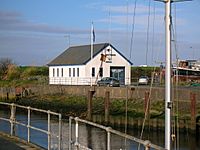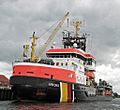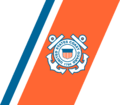Coast guard facts for kids
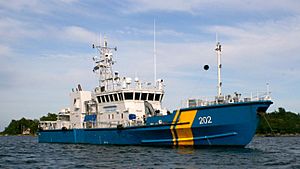

A coast guard is a special group that helps keep the waters safe in a country. Their main job is to protect people and the environment at sea. What a coast guard does can be very different from one country to another.
Some coast guards are like a part of the military. They might carry weapons and help with customs (checking goods coming into the country) and security. Others are volunteer groups that focus on search and rescue missions. These volunteers might not have the power to arrest people.
A coast guard's work is usually different from a country's navy (which is purely military). It's also different from regular police who work on land.
The Story of Coast Guards
The idea of a coast guard started a long time ago. In the United Kingdom, the group that became Her Majesty's Coastguard began in 1809. It was first called the Waterguard.
The Waterguard's main job was to stop smuggling. People would try to sneak things like brandy and tobacco into the country without paying taxes. This was a big problem back then. Smugglers would land their goods on beaches at night from small boats.
But the Waterguard also had another important job: helping ships that were in trouble. They would assist with shipwrecks.
Each Waterguard station had a special tool called a Manby mortar. This was invented by Captain George William Manby in 1808. The mortar could fire a shot with a rope attached from the shore to a wrecked ship. This helped rescue people from sinking vessels. This is how the Coastguard started to become a life-saving service.
In 1822, the Waterguard was officially renamed the "Coastguard." In 1845, it became part of the Admiralty, which was in charge of the navy.
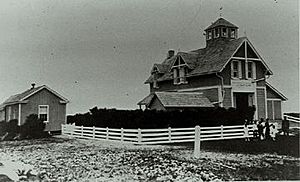
In 1829, the first rules for the UK Coastguard were written. These rules said that if a ship was wrecked, the Coastguard had to do everything possible to save lives. They also had to protect the ship and its cargo.
In the United States, the United States Coast Guard was formed in 1915. It was created by combining two older government groups. One was the United States Revenue Cutter Service. This group enforced customs laws at sea and helped the United States Navy during wars.
The other group was the United States Life-Saving Service. This service started in 1848. It had crews stationed along the eastern coast to save lives from shipwrecks. Later, the Coast Guard also took over the jobs of the United States Lighthouse Service and the Bureau of Navigation and Steamboat Inspection.
What Coast Guards Do
Coast guard services have many important jobs. Here are some of them:
- Search and Rescue: Finding and helping people who are lost or in danger at sea.
- Enforcing Maritime Law: Making sure people follow the rules and laws on the water.
- Vessel Safety: Checking that ships and boats are safe to use.
- Maintaining Seamarks: Taking care of buoys and lighthouses that guide ships.
- Border Control: Protecting a country's borders at sea and stopping illegal activities.
During times of war, some coast guard groups might also help their country's military. They might protect harbors, keep ports safe, or patrol the coast.
The role of a coast guard can be different depending on the country. For example, the United States Coast Guard is a military branch. This means it's part of the armed forces, but it also has the power to enforce laws.
On the other hand, the United Kingdom's Her Majesty's Coastguard (HMCG) is a civilian group. Its main job is only search and rescue.
Most coast guards use ships and aircraft like helicopters and seaplanes. They either own or rent these vehicles to do their jobs.
Some coast guards, like the Irish Coast Guard, have very limited law enforcement powers. They might only check ships in their ports to make sure they are safe. In some cases, the Coast Guard might just coordinate rescue operations. The actual rescue boats might be provided by volunteer groups, like the Royal National Lifeboat Institution in the United Kingdom. Aircraft might come from the country's armed forces.
Images for kids
-
USCG National Security Cutter USCGC Bertholf (WMSL-750) and an EADS HC-144 Ocean Sentry
-
Norwegian Coast Guard vessel KV Nordkapp off Svalbard
-
Russian Border Guard vessel Vorovskiy in Seattle
-
A third generation patrol craft of the Police Coast Guard conducting a sea-rescue demonstration off the southeastern coast of Singapore
-
CASA C-212 series 400 of the Vietnam Coast Guard
See also
 In Spanish: Guardia costera para niños
In Spanish: Guardia costera para niños


